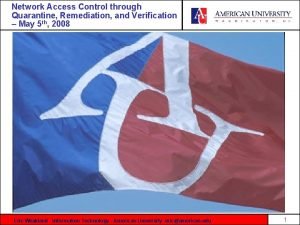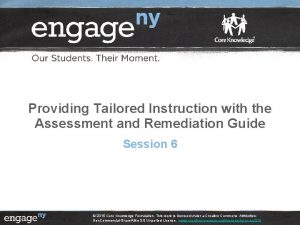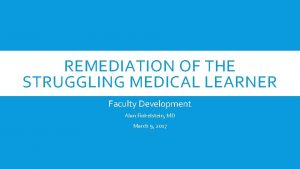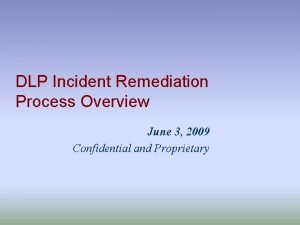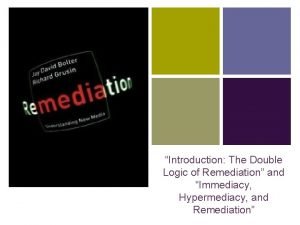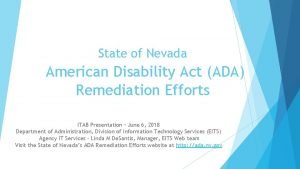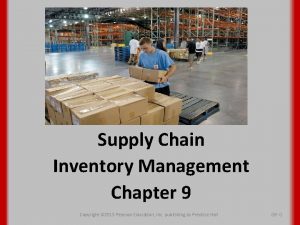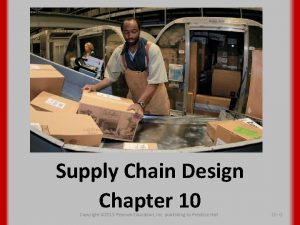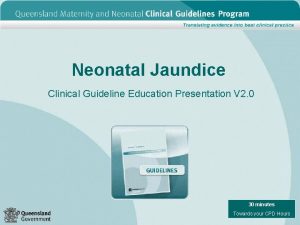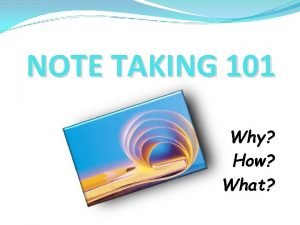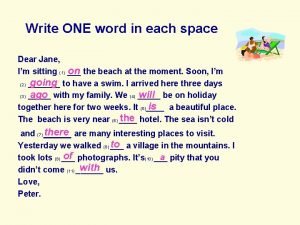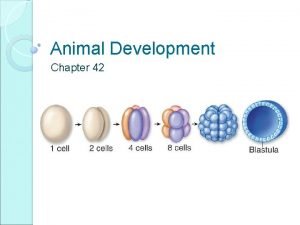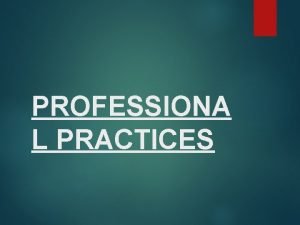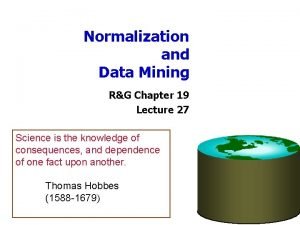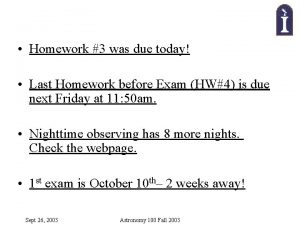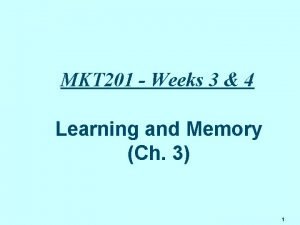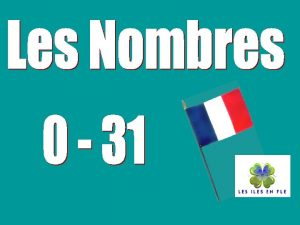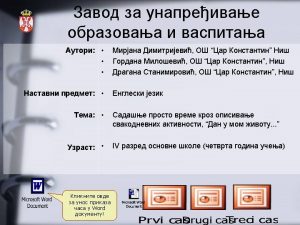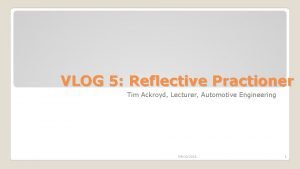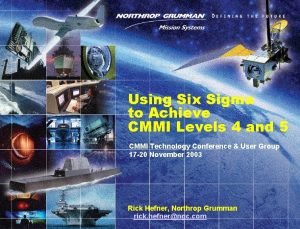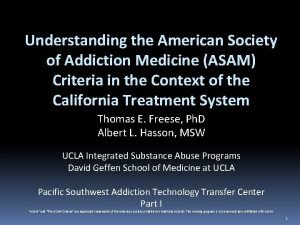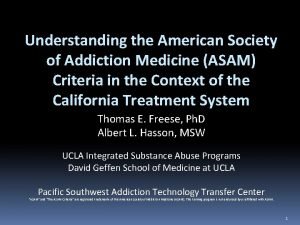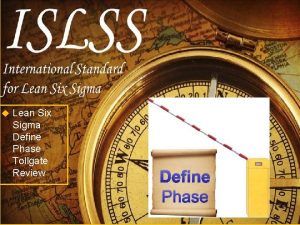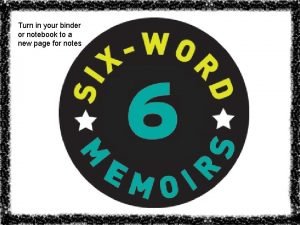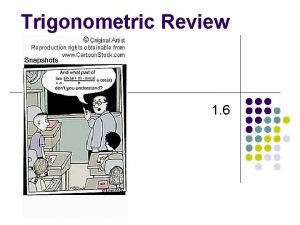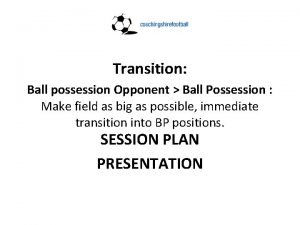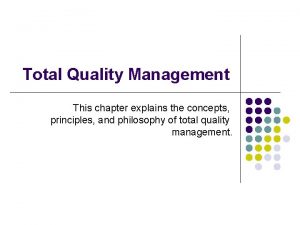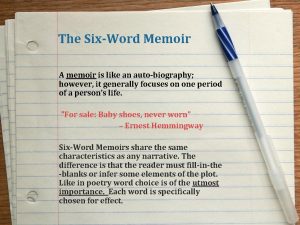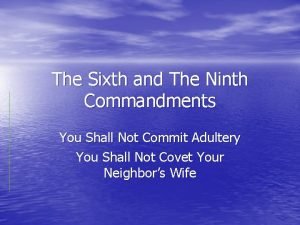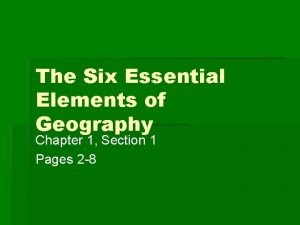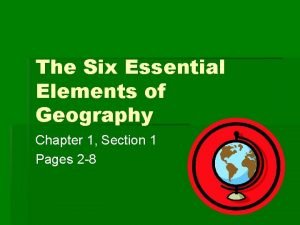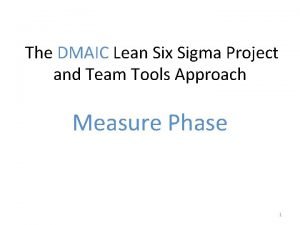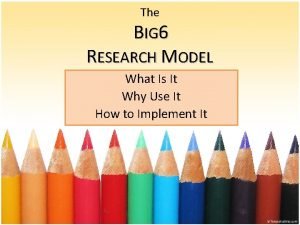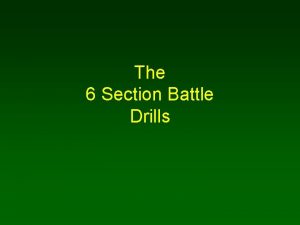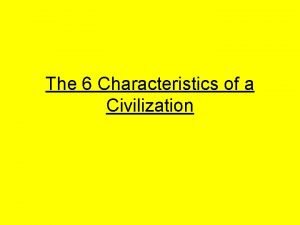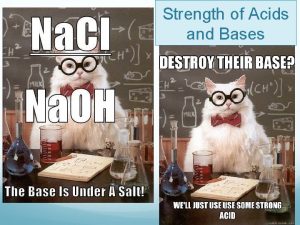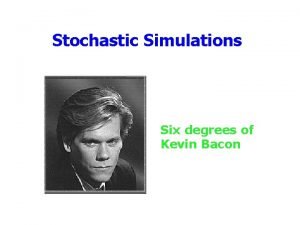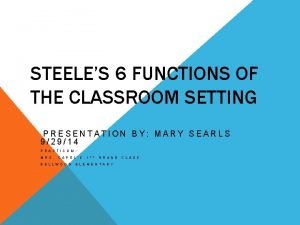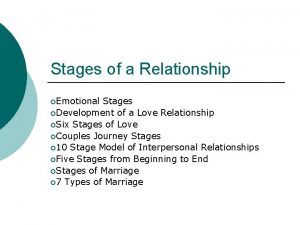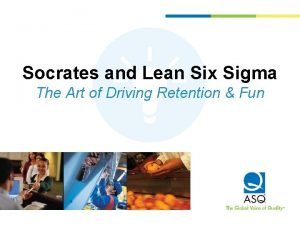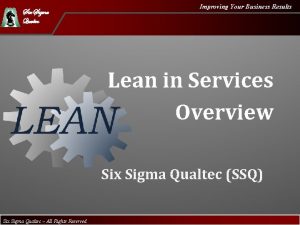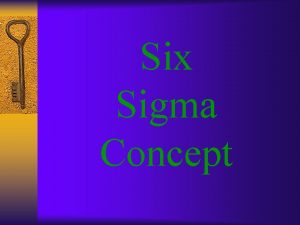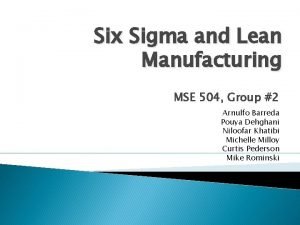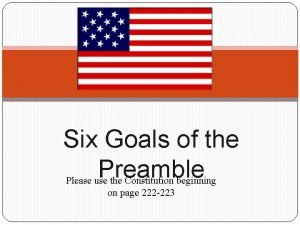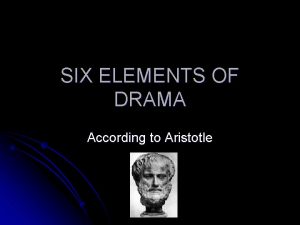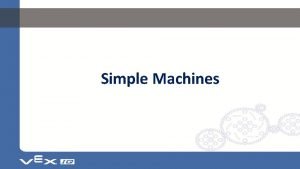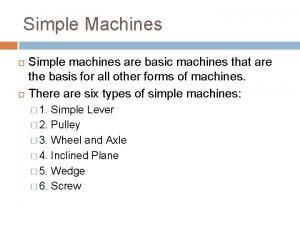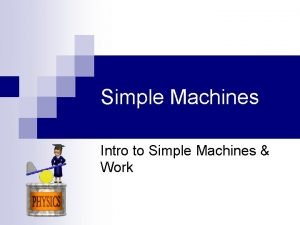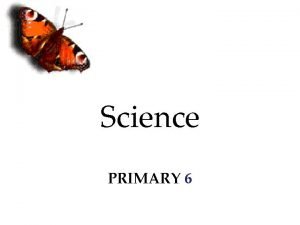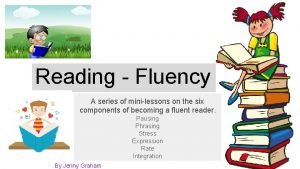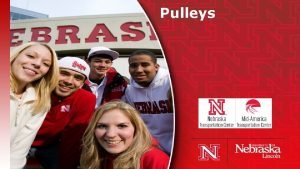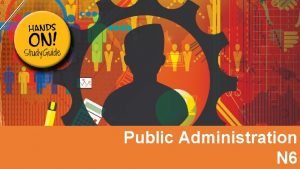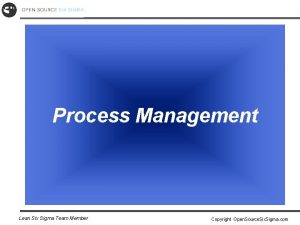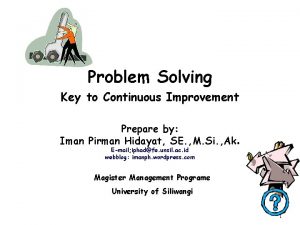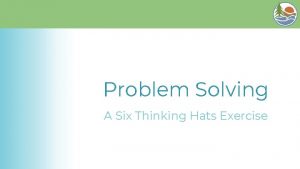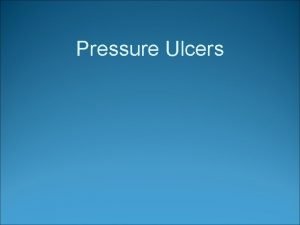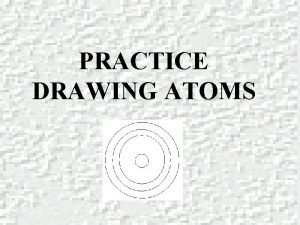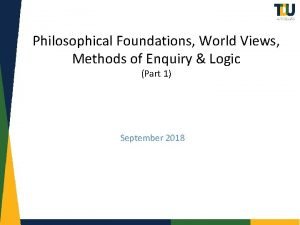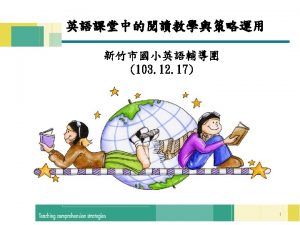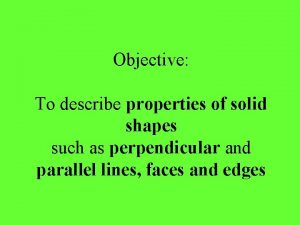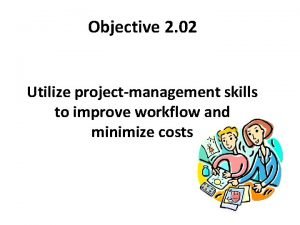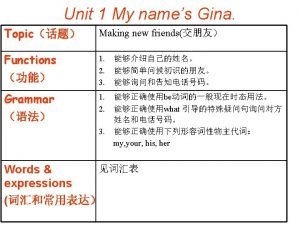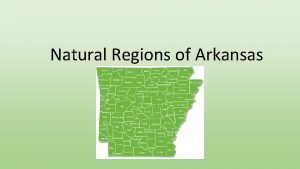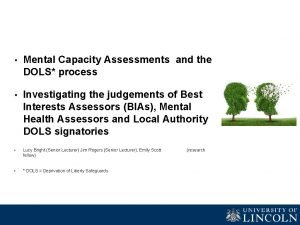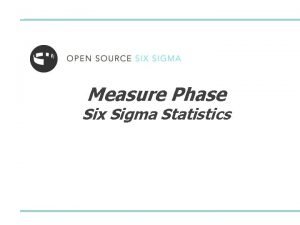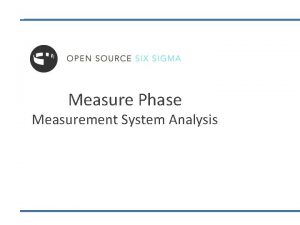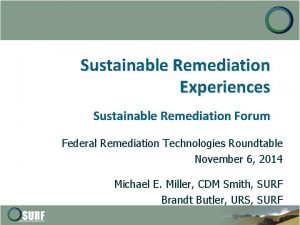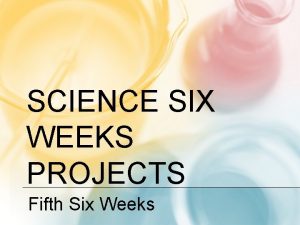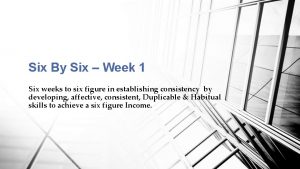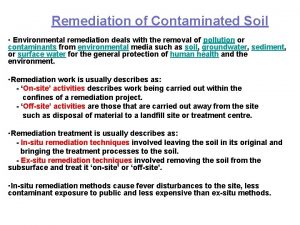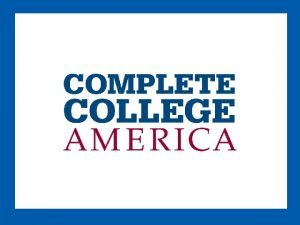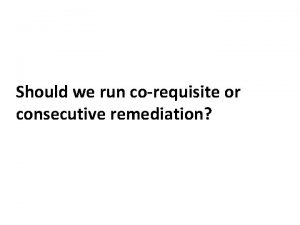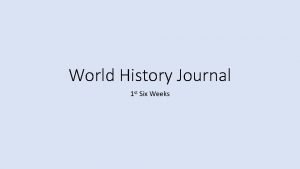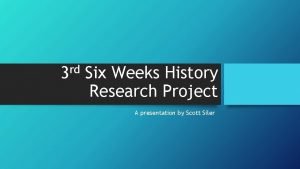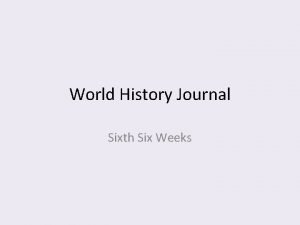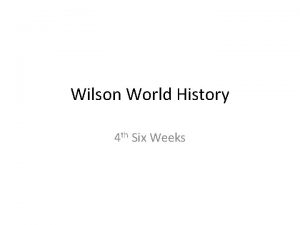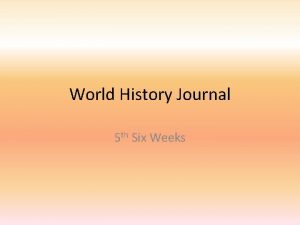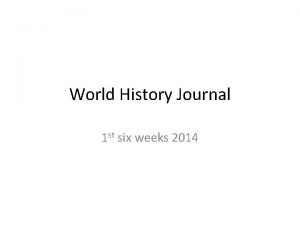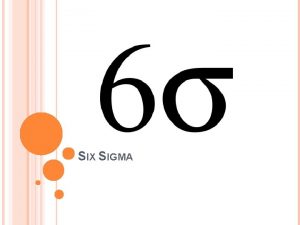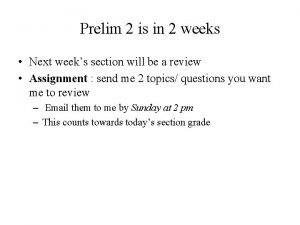US History II 2 nd Six Weeks Remediation
































































































































- Slides: 128

US History II 2 nd Six Weeks Remediation

WWI Key Terms to Define Neutrality: � U-boats � Lusitania: � Zimmerman Telegram: � Rationing: � 14 Points: � League of Nations:

Declaring Neutrality �All of the major European nations are in a bloody war over imperialism, nationalism, and militarism. �Millions of men are dying. �President Wilson feels that the war is a European affair and that we should stay out of it. �Some want us to support the British and the French. �Can we trust the immigrants here?

U-boats � German for “Unterseeboots”, we know them as submarines. � These weapons first become a major war weapon during WWI. � The Germans use the submarines to starve the British out of the war by sinking ships loaded with food and supplies. � Many of the ships are American. The unrestricted submarine warfare will be a major cause of bringing the United States into WWI. The Lusitania was a British ocean liner that was a passenger cruise ship running the North Atlantic Sea Route. The ship was torpedoed and sunk by a German U-Boat on May 7, 1915 of the coast off Ireland. The incident came very close to bringing the United States into the war as 1, 198 innocent passengers were killed…including 128 Americans. Germany agreed to end unrestricted submarine warfare after this, however began to do it again in 1917. It is also believed that the liner may have been secretly carrying weapons and ammunition for the British.

Zimmerman Telegram �Atelegram sent by the Germans to the Mexican government. �As war with the US seemed likely, Germany offered Mexico a deal that if Germany goes to war with the US, if Mexico attacks America, the Germans will help them get Texas, California, Arizona, and New Mexico back. �When the American people heard about this, it turned the public opinion towards war. �In early 1917, Germany resumes unrestricted submarine warfare in the Atlantic �Two months after the Zimmerman Telegram was discovered, US President Woodrow Wilson asked Congress to declare war on. April 2, 1917 and help the Allies win.

US Fights �The first battle that the Americans fought at was the Second Battle of the Marne. � The Allies halted a thrust by the Germans from July 15 -18, 1918 to take Paris. �The new American forces held the Allied line and weakened the German forces. �It was the last major German offensive of the war. �US forces push into the Argonne Forest and Belleau Wood in late October and begin to push towards the German border. �The Germans will surrender in November.

Question Time � 1. Why did Wilson try to keep us out of WWI? � 2. Why was it hard for him to do this? � 3. Why did the US end up going to war? � 4. How did America tip the balance in favor of the Allies?

The Home Front �In US and Britain, people back home had to resort to rationing goods. �Rationing is a system of making sure that everyone gets a fair share of needed supplies while the bulk of the supplies gets sent to the war effort. �Goods from butter, iron, rubber, wheat, meat, shoes, leather, etc. were all rationed during the war years on both sides. �This would ensure that the troops were taken care of while the people at home had what they needed to survive as well. �“Victory gardens” “Freedom burgers” and “Liberty sausages” �Women work in factories.

Immigrant Hysteria �People worried that immigrants may be working for enemy nations. �Orchestras would refuse to play Mozart, Bach, Wagner, and Beethoven. �Some people changed their names to be “more American. ” (“Von Braun” to “Brown”) �Some towns changed the names. (New Berlin, NY became New Berlin, Vienna, NY became Vienna, NY). �Many immigrants tortured, lynched, beaten, or abused.

Social Issues During the War �Women working some factory jobs as well as driving taxis, cooks, miners, bricklayers, and dockworkers. Helped win them suffrage �Many Blacks moved from the South to the North looking for jobs. �Henry Ford allowed Blacks to work in his plant, but paied them a lot less money. �Blacks found a lot of prejudice up North.

Senate Rejection �Part of the treaty to end the war includes the creation of a “League of Nations”, an international organization determined to keep the peace. �Wilson has a stroke while campaigning for the treaty. With Wilson sick, the treaty has little chance of passing. �Henry Cabot Lodge, a Republican and Chairman of the Foreign Relations Com. on the Senate, rejects the treaty. �Fears the League of Nations will get us into war without the Senate’s consent. �Senate rejects treaty, but signs a treaty with Germany in 1921. �US does not join League of Nations.

Question Time � 5. What sacrifices were made by the people back home? � 6. Why were people so afraid of immigrants? � 7. What social issues were there during the war? � 8. How did the flu kill so many all over the world in 1919? � 9. Why did the Senate reject the treaty?

Roaring 20 s Key Terms to Define Isolationism: � Nativism: � Red Scare � Immigration Quotas: � Sacco and Vanzetti: � Prohibition: � Flappers: � Scopes Monkey Trial: � Harlem Renaissance:

Postwar Issues �Isolationism—stay out of foreign affairs. �Nativism—fear of immigrants. Red Scare—fear that communism would spread in the US. 70, 000 Communist Party members in the US. Many people upset at influx of immigration after WWI. Many people left to escape the harsh life of postwar Europe. 1919: 141, 000 immigrants. 1921: 805, 000 immigrants. Emergency Quota Act of 1921 set up a quota to establish a maximum number of immigrants allowed from one country by allowing only enough immigrants that equaled 2% of people of that ethnicity in this country in 1900. Later amended to 1920 by the Origins Act of 1929. Origins Act also allows only 150, 000 immigrants in total.

Sacco and Vanzetti �Nicola Sacco and Bartolomeo Vanzetti were Italian immigrants. �They were socialists and evaded the draft. �In April 1920, two men shot and killed a factory paymaster and then robbed him of $15, 000. Sacco and Vanzetti were accused. �Witnesses said “Italian looking men” did the deed. �Three weeks later they were charged with the crime. �Even though all evidence was circumstantial, the judge found them guilty and made some derogatory comments. �They were executed by electric chair despite nation and world wide protests.

Rise of the Klan � Revived in 1915 by William J. Simmons in response to immigrants (especially Catholics and Jews). � Inspired by Birth of a Nation. � Starts cross burning. � Oppose unions and communism. Supports prohibition. � 60, 000 members will march on DC in 1925. � Klan will reach over 6 million members by 1924. After arrests, trials, and bad publicity, the Klan will drop to 30, 000 members in 1930.

Question Time � 10. Why did the KKK get such a boost after WWI? � 11. How do you feel about the Sacco and Vanzetti case? Explain. � 12. Why did we fear all these new immigrants?

Moving to the City �Differences between rural and urban. Urban seen as immoral. Rural seen as hickish. � 2 million people leave farms to go to the cities each year between 1920 -1929. �NYC had 5. 6 million. Chicago had 3 million. Philly had 2 million. � 65 cities had populations of more than 100, 000 �Cities evolve nightlife. �Automobiles give people a sense of freedom.

Prohibition and the Mob �Prohibition was passed in 1920 with the 18 th Amendment. �Drinking goes underground. Irish and Italian mobs take the business. �Speakeasies—illegal establishments that sold liquor. �Bootleggers—people who smuggle booze. �Violence rises as the gangs go to war.

Prosperity? �Businesses were producing a great amount of goods. �Branch Banks �Chain Stores �Buying on installment �Buying on credit �Stock market seems good way to make money.

�The Flapper: short haired, usually with a hat, androgynous in appearance, bright colors, dresses that came up to knee length, black stockings, high heels, beaded necklaces, bracelets, and lots of makeup. �Flapper seen as emancipated woman free to do what she wants. �Flappers would smoke and drink (previously taboo). �Marriage seen as equal partnership, but housework was a woman’s job. �Marriages become more and more common a choice between two people and not parent’s choice. —divorce rate doubles. �Double standard develops between men and women. �Women get increasing opportunities at factories and businesses. First time women enter the workforce in a big way. Women in the 1920 s

The New Morality � Marriage began to be redefined among the younger generation – they began to believe that a successful marriage required romance, friendship, and sexual compatibility rather than just a sense of duty to one’s family � Young people also began to focus on having fun, something that became more available to them with the increased mobility offered by automobiles

Scopes Monkey Trial �John Scopes taught evolution in Tennessee and was arrested for it. �It was against the law in several states to teach it. �ACLU hired Clarence Darrow to defend Scopes. �William Jennings Bryan serves as prosecutor in the case. �Case becomes a national sensation. �Bryan called on as a witness by Darrow as an expert on the Bible. �Scopes found guilty and had to pay $100 fine, but changed the verdict later on a technicality. �Law remained on the books.

Harlem Renaissance �Amovement in Harlem by Black artists. �Movement can be seen in poetry, literature, and music. �Celebration of Black culture. �Langston Hughes �Zora Neale Hurston �Claude Mc. Kay �Louis Armstrong �Duke Ellington �Bessie Smith �Ella Fitzgerald �Josephine Baker �Cab Calloway

Question Time 13. In what ways was the Black culture celebrated in the 1920 s and 1930 s? � 14. How did prohibition help the growth of the mob? � 13. Compare religious fundamentalism with the changing morals? � 15. How do we still see the effects of the scopes monkey trial today? � 16. What issues do you see back then that are still important today?

Great Depression Key Terms to Define � Buying on Margin: � Speculation: � Stock Market Crash: � Hawley Smoot Tariff: � Hoovervilles: � Bonus Army: � New Deal � Fireside Chats: � FDIC: � TVA: � Court Packing Plan:

The Economy of the 1920 s �Many companies were either losing money or barely making a profit: textiles, railroads, lumber, mining, coal, and steel due to increased overseas competition, lack of postwar business, and rise of the automobile. �Demand for consumer goods begins to drop. Companies lose money. �Housing market starts to drop. �More people buying on credit, living beyond their means. Some couldn’t pay what they owed.

Buying Stocks �Buy low, sell high. �Speculation: buying high risk stocks to sell them later. �Margin: buy a stock at only a fraction of the price with banks or stockbrokers lending rest—up to 75%. When you sell, you divide the profits up evenly. If they fell, you owed the lender.

October 29, 1929 �As the summer of 1929 went on, the stock prices kept rising. By. Sept. , they leveled out. Some felt that tough times were ahead and began to sell their stocks. �On October 24, 1929, the stock market had a small crash as more investors began to pull out. �On Black Tuesday, the stock market plunged. � 16 million shares were “dumped”

The Reality of the Stock Market Crash �The Depression did NOT happen just because of the stock market crash alone. It was the catalyst. �Banks lost money in market. Banks either forced people to payback loans, or the banks went bankrupt. �People lost life savings. �Creditors needed money badly. People were living beyond their means. �Inequality in economic classes.

Financial Collapse �Because of the crash, 659 banks closed in 1929 and 6, 00 0 banks fail by 1933. (25%) � 28 states had no banks in them at all. � 85, 000 businesses went bankrupt. � 1/3 of all railroads go bankrupt. � 13 million workers (25% of working pop. ) were out of work by 1933 (from 1. 6 in 1929). �Other workers had to deal with pay cuts and/or shorter hours.

Hawley-Smoot Tariff �Passed in 1930 as an emergency act to jumpstart the economy. �Raised tariffs on foreign goods to about 20% �Worldwide trade stops as other countries do similar things. Worldwide trade drops 65%. �Depression spreads across the world hitting places like Germany, France, Britain, Austria, and Canada really hard. �Tariff helps to lead to more unemployment.

Question Time � 17. So what was the actual reason for the depression? � 18. Why did the banks lose so much money? � 19. How did the banks going bankrupt make things worse? � 20. How did the Hawley-Smoot Tariff make it worse?

Hoover’s Response �Depressions had happened before. Hoover, like many Americans, felt this was natural. �He felt that the government should do very little to relieve the Depression. �Hoover felt that most Americans should either look to charities for help or try to help each other out/help themselves out. �Hoover also felt that people should help themselves rise above the crisis. �Hoover was opposed to federal welfare programs, direct relief efforts, and handouts.

Blame Hoover �Democrats sweep 1930 midterm elections taking control of the House and bringing the Republican Senate majority down to 1 vote. �“Hoovervilles” “Hoover Blankets” “Hoover Leather” and “Hoover Wagons” �Democrats portray Hoover as “doing nothing” and “not caring. ”

The Bonus Army �Veterans from WWI were owed a bonus for fighting in the war. The bonus was to be paid in 1945. �With the Depression on, many vets wanted and needed that money now. � 10 -20, 000 vets march to Washington in late spring of 1932 get their bonus. They camped out in the National Mall. �On June 17 1932, the Senate voted a bill down to give the vets their money. �Hoover asked the men to go home, but 2, 000 remained. �On July 28, 1932, Gen. Douglas Mc. Arthur leads a force of 1, 000 soldiers against the vets and attacks them with tear gas. Made Hoover look bad.

�On June 17 1932, the Senate voted a bill down to give the vets their money. �Hoover asked the men to go home, but 2, 000 remained. �On July 28, 1932, Gen. Douglas Mc. Arthur leads a force of 1, 000 soldiers against the vets and attacks them with tear gas. �Bad PR for Hoover.

Question Time � 21. Why did Hoover take little action during the opening parts of the Depression? � 22. What happened with the Bonus Army? � 23. Why did so many people blame Hoover for everything?

Election of 1932 �By 1932, most Americans have had enough of Hoover. �Hoover also made a lot of promises in 1928 to help Blacks out and didn’t keep them. �Democrats nominate Franklin Delano Roosevelt to run for president. �FDR’s message of hope helps him cruise to victory.

The Hundred Days �FDR’s first 100 days saw a lot of activity due to the demands of the Depression �He called his policy “The New Deal”. �From March 9 -June 16, 1933, Congress will pass 15 major legislative bills. �From this time forward, most presidents have their first 100 days judged because of FDR.

The Hundred Days �One of the first things FDR did was call a “bank holiday” on March 5, 1933. �Congress passed the Emergency Banking Relief Act which would allow only those banks that are economically viable to reopen. �Those that remained closed could apply for loans so they could function later. �This helped ease tensions and end runs on banks. Restored confidence in banks.

The Fireside Chats �Used by FDR to give hope to Americans. �Speeches on topics that he gave over the radio. �Started most of them with “Good evening friends”. �Helped make him real popular with the public.

Fixing the Banks �Glass-Steagall Banking Act of 1933—creates the Federal Deposit Insurance Corp. (FDIC) Guarantees money up to $5, 000 in bank in case bank fails. �Federal Securities Act: requires corporations to provide complete info. on all stock offerings and makes them responsible if there is any misrepresentations. �SEC—Security Exchange Commission regulates the stock market. Prevents insider information and price gauging. �Restored confidence in the banks and stock market.

Prohibition �Prohibition had brought the rise of crime because of the mafia. �More people were drinking and doing other illegal things. �In 1933, the 21 st Amendment passed which repealed the 18 th Amendment—the “noble experiment” was over. �The 21 st Amendment gives the states the right to regulate and restrict the sale of alcoholic beverages.

The Alphabet Soup Acts and Agencies �AAA: The Agricultural Adjustment Act. This will raise crop prices by lowering production. It would pay farmers not to grow crops on their land paid cotton and pig farms to destroy some of their stock. �CCC: Civilian Conservation Corps. Paid young men (18 -25) to work building roads, developing parks, digging ditches, planting trees, flood control, irrigation etc. Workers got $30 a month, $25 of which was sent home to the families. �FERA: Federal Emergency Relief Act. Gave $500 million to provide direct relief to the needy with grants for food, medicine, and clothing �NIRA: National Industrial Recovery Act created the NRA (National Recovery Admin. ) that fixed prices, established standard working hours, and banned child labor.

The TVA �Tennessee Valley. Authority �Built dams in the Tennessee River Valley. �Provided electricity, jobs, and flood control for many poor people in the South.

The WPA �Works Progress Association �Had a budget of $5 billion to create jobs. �Between 1935 -1943, it employed 8 million people. �Built 850 airports, 111, 000 libraries, schools, and hospitals. �Constructed or repaired 651, 000 miles of road. �Also employed writers, teachers, and artists. �NYL: National. Youth Admin. gave aid and employment to young men. 2 million employed.

The Court Packing Plan �Supreme Court had ruled some New Deal plans unconstitutional. �Judicial Reorganizing Bill of 1937 �FDR felt that the Supreme Court was stopping his plans by declaring laws unconstitutional. �He proposed this bill which would add a new Supreme Court justice for every current justice over the age of 70 ½. There were 6 judges on the court this applied to. �With more support on the bench, he could pass anything. Is he a dictator? �Very unpopular bill with the American people and political opponents with FDR. �FDR withdrew this bill.

Labor Reforms �Wagner Act which would allow unions to use collective bargaining with employers. �Wagner Act also forbade companies from firing workers just because they are in a union, threatening workers, and interfering with unions. �NLRB: National Labor Relations Board is also set up by Wagner Act. Hears testimonies about unfair labor practices and holds elections amongst workers to see if a union is desired. �Fair Labor Standards Act establishes minimum wage in 1938. 25 cents/hour. Banned factory labor for workers under 16.

Social Security Act �Passed in 1935. �Provides a “old-age insurance” for retired people. It is not a pension, but provides some money for older people to subsist off of. �Money would be put into an account by the worker and the employer to be given to older citizens. When that worker is older, he can collect benefits from it too. �Created unemployment benefits to people at the state level. �Gave aid to families who have dependent children or who are on permanent disability.

The Effects of the New Deal �More government influence in economy and business. �Still use FDIC and SEC. �Social Security is first of many social programs we have. �TVAstill is in operation. �Gave federal help to farmers we still see today. �More taxes. �More environmental conservation. �More government deficit spending. �Some feared a communist revolution. Others felt New Deal saved us from one.

Question Time � 24. Which New Deal agency do you think was the most important and why? � 25. What reforms did labor unions win? � 26. Why was the court packing plan so unpopular? � 27. What is social security and why do we have it?

WWII Key Terms to Define � Fascism: � Totalitarianism: � Appeasement: � Isolationism: � Rationing: � Pearl Harbor: � Internment Camps � Island Hopping: � Kamikaze: � Atomic Bombs:

In the Years Following WWI �Treaty of Versailles has hit Germany hard. �Germany’s currency, the mark, dropped in value. The Germans also printed more money to get out into the public’s hands which also devalued the currency and it became worthless. �Great Depression hits Europe really hard. �Many countries will give up rights for security or sacrifice standing up for peace. �Fascism and totalitarianism take root in Europe. Dictators like Hitler, Mussolini, and Stalin come to power.

Aggression Begins �“Lebensraum”: Living space in German. �It is a major theme in Mein Kampf. �Accoring to Hitler, the Germans need room to expand because they will become overcrowded. �They should first unite all the lands Germany used to own (parts of Poland, Czechoslovakia, Austria, etc. ). �Afterwards, the Germans should expand eastward into Poland, Ukraine, and Russia and use the farming lands here as a base of supply for food. �The Slavic populations will be converted to slaves. �Lebensraum will be the cornerstone for what Hitler called “The Third Reich” which “would last for 1, 000 years”. �“Master Race”

Germany makes demands. Threatens war. The Allies meet with Germany. Appeasement Cycle Toprevent war, Allies agree to the German demands. Germany senses weakness in the Allies.

Hitler’s Aggression �Hitler remilitarized the Rhineland in violation of the Treaty of Versailles. �Forced a union with Austria. �Bullied Czechoslovakia into ceding the Sudetenland. �Annexed all of Czechoslovakia �Demanded Poland surrender “Polish Corridor”

Meanwhile…in China � Japan invaded Manchuria in 1931, the Japanese and created the puppet state of Manchukuo. � The Japanese promoted Japanese colonization of the region. � The Japanese invade China in 1937 and capture Beijing, Shanghai, Nanking, and other coastal cities. � The Chinese, weakened by years of civil war, are easy prey to the stronger Japanese armies with over a million fighting for Shanghai alone. � From 1937 -1945, the Chinese will lose 3. 2 million killed while the Japanese lost more than a million. � Another 17. 5 milllon Chinese will die in the Japanese atrocities committed by the military. � Rape of Nanking: From December 1937 to January 1938, the Japanese go crazy in the city of Nanking. They rape women and children in the city and go on a murder spree of the civilian populace. In six weeks, their genocidal acts will kill 300, 000 innocent people.

The Road to World War II 1. Mussolini Invades Ethiopia in 1935. 2. Hitler remilitarizes the Rhineland in 1936. 3. Hitler and Mussolini aid Franco in the Spanish Civil War. 4. Hitler annexes Austria in 1938. 5. Hitler demands the Sudetenland from Czechoslovakia in 1938. 6. Hitler is given Sudetenland in Sept of 1938. 7. Hitler takes over rest of Czechoslovakia in 1939 and divides it with Hungary. 8. Mussolini takes over Albania in 1939. 9. Hitler demands Poland surrenders the Polish Corridor in 1939. 10. Hitler and Stalin sign non-aggression pact in Aug 1939. 11. Sept. 1, 1939—Hitler invades Poland

US Isolationism �Germany is taking over parts of Europe. Japan is at war with China. �In the years following WWI, the US will stay out of European affairs as it deals with the Depression. �We did not want to get involved in the war in Europe because of the death and destruction before. �Combined with Appeasement, it will help Germany branch out.

Lend Lease Act � While we do not get involved in the war quite yet, we are seen as friends of the Allies. � In 1941, Congress passes the Lend- Lease Act. � Initially, it would cost $7 billion but eventually be $50 billion. � “Arsenal of Democracy” � We would lend weapons and money to Allied countries (mostly Britain, France, China, Australia, and…later on…USSR). Britain would let use navy bases in Caribbean in return. Aircraft 14, 795 Tanks 7, 056 Jeeps 51, 503 Trucks 375, 883 Motorcycles 35, 170 Tractors 8, 071 Guns 8, 218 Machine guns 131, 633 Explosives 345, 735 tons Railroad freight cars 11, 155 Locomotives 1, 981 Cargo ships 90 Submarine hunters 105 Ship engines 7, 784 Food supplies 4, 478, 000 tons Machines and equipment $1, 078, 965, 000

Atlantic Charter �Meeting between FDR and Churchill to discuss aims of the war. �No territorial gains were to be sought by the United States or the United Kingdom. �Territorial adjustments must be in accord with wishes of the peoples concerned. �All peoples had a right to self-determination. �Trade barriers were to be lowered. �There was to be global economic cooperation and advancement of social welfare. �Disarmament of aggressor nations, postwar common disarmament �Defeat of Germany and other Axis powers. �Would push us closer to war with Germany.

Question Time � 28. What was the goal behind appeasement? � 29. Why did appeasement not work? � 30. Why did the US want to stay neutral and be isolationist? � 31. How did the Lend Lease Act and the Atlantic Charter push us closer to war?

Embargo of Japan �Meanwhile, Japan is continuing to attack China’s cities. �As the Japanese become more and more aggressive, the United States refuses to trade several raw materials with Japan (oil, steel, etc. ). �This embargo really hurts the Japanese war efforts (we had 80% of their oil supply) and convinces them that the United States is out to get them. �While they want to expand towards Indonesia, they feel that would bring the US into the war. �When Tojo became prime minister, he pushes for a war with the US.

Attack at Pearl Harbor �Planned by Isoroku. Yamamoto. �It would be a “knock out blow” designed to destroy the US fleet and force us to surrender. �Asurprise attack on the American naval base in Hawaii on Dec. 7, 1941. � 8 battleships and 8 cruisers were lost along with 2, 400 lives. Carriers spared. �The attack brings the US into the war. �Germany and Italy declare war on the US too.

The Home Front �Many people join the armed forces. �FDR brings back the draft. 10 million drafted. � 16 million Americans will serve in the armed services and 400, 000 will be killed. �WAAC—Women’s Auxiliary Army Corps would free up valuable manpower for the war, but they wouldn’t get equal rank or pay. � 6 million women go to work— “Rosie the Riveter”

The Home Front �Most goods are rationed for the war effort: gas, leather, meat, sugar, coffee, etc. �People donated copper, tin, steel pots and pans as scrap metal. Rubber tires too. �All factories converted to war effort. �No strike pledge by unions. �Cartoons go to war.

Japanese Internment �Nisei—Japanese people born in this country, were sent to live in internment camps. �Afraid they were spies. 110, 000 sent away in Feb. 1942. (11, 000 Germans) �Held there until 1946. �Korematsu vs US—man sued government for internment. Court ruled government could do it because it was during a time of war and civil liberties can be restricted.

Question Time � 32. Why was Japan so angry with the US? � 33. Japan thought that they could knock us out of the way by attacking Pearl Harbor. Why were they wrong? � 34. Why did we put the Japanese in internment camps?

Normandy Invasion � Also known as D-Day. It is the largest amphibious invasion in the history of warfare. � On June 6, 1944, over 150, 000 in the initial waves American, British, and Canadian men land on beaches codenamed Utah, Omaha, Gold, Sword, and Juno on the coast of Normandy on the English Channel. � It is the beginning of the liberation of France and Western Europe. � Codenamed “Operation Overlord”, it will begin the drive to Berlin. � At the end of June, over 3 million Allied forces will have landed. � 1, 500 dead and 5, 200 wounded

Yalta and Potsdam Conferences �Ameetings held to discuss postwar aims. �The meeting discussed the goals for the final months of the war: Unconditional surrender of Germany, Division of Germany into occupied zones, Demilitarization and Denazification of Germany, Reworking Poland’s borders, the United Nations, and getting the USSR to fight Japan. �It also focused on free elections in Eastern Europe where the Soviet Union had liberated the nations there.

Defeat of Germany �American forces cross the Rhine River at Remagen in March 1945. �Mussolini is executed by Italians. �Russians are poised to take over Berlin. �Allied bombers are destroying German factories and cities. �Berlin is captured by the Soviet forces and Germany is compelled to surrender. �Hitler commits suicide on April 30 �V-E Day: Victory in Europe Day, May 8, 1945. It is the day that Germany surrenders.

Island Hopping �The strategy employed by the US of bypassing heavily fortified Japanese positions and instead concentrating on strategically important islands that were less well defended but capable of supporting the drive to the main islands of Japan. �The Allies would “hop” over the other islands on their way to Japan.

Kamikaze �Japanese word for “divine wind”. �As the Americans creep closer to Japan, the Japanese become desperate. �They begin to load their planes up with bombs and extra fuel and deliberately crash them into the American ships. � 3, 912 Japanese will sacrifice themselves for their emperor. � 34 navy ships were lost and 368 were damaged at a cost of 4, 900 dead and 4, 800 wounded. �Only 14% of the kamikazes hit their target, but the desperate efforts help led to the Manhattan Project. �The closer we get to the Japanese mainland, the more bloody the battles are becoming.

The Manhattan Project �Code name used for development of nuclear weapons at Los Alamos, NM and Oak Ridge, TN. �Led by J. Robert Oppenheimer and others, physicists attempt to create nuclear fission and then harness this energy for the first nuclear weapons. �Two bombs were made: one from uranium and one from plutonium.

Using the Atomic Bomb �It would help to end the war quicker. �Japan seemed to want to fight to the death. �Japan refused to surrender. �Would save American lives. �Scare Soviet Union in future. �Prevent Soviet Union from taking over too much land in Asia.

Hiroshima and Nagasaki �The first time nuclear weapons were ever used in combat. On Aug. 6, 1945, a B-29 named Enola Gay dropped the uranium “Little Boy”on Hiroshima. � 70 -100, 000 people were killed with over 90% of the city destroyed. Three days later, Bockscar drops “Fat Man” on Nagasaki. �Again, 80, 000 die in and following the attack. �On August 14, the Japanese agree to surrender. �WWII ends on Sept 2, 1945. �

Question Time � 35. What led to the ultimate victory over Germany? � 36. What decisions were made at the. Yalta and Potsdam Conferences to keep the peace after the war? � 37. What was the rationale behind dropping the atomic bombs?

Holocaust �“The Final Solution” �Over 6 million Jews and 6 million others (Poles, Russians, Gypsies, Handicapped, Mentally Ill, Catholics, Communists, Jehovah’s Witnesses, Homosexuals, etc. ) were killed in concentration camps. �The Final Solution refers to the “final solution of the Jewish Question”…what to do with the Jews. �Auschwitz was the largest of the Nazi death camps. Between 1 -2 million people die at this camp alone. (on average 1, 200 a die from its opening in 1940 to liberation on Jan. 27, 1945)

Nuremburg Trials �War crime trials held from 1945 to 1949 to convict Nazi leaders for various war crimes. �Out of the 24 major criminals, 12 are sentenced to be executed and 3 are sent to life. �Others have other sentences or are acquitted. �Overall, about 185 individuals were indicted in the 12 cases. �Anumber of doctors and SSleaders were condemned to death by hanging, and approximately 120 other defendants were given prison sentences of various durations; 35 defendants were acquitted. �It is a landmark for the upholding of human rights in the world.

Race Relations in the War �Blacks fought in segregated units. �Japanese-Americans could only fight in Europe. �Navajo Indians used as “code talkers” in the Pacific Theater.

Question Time � 37. Describe some of the events of the Holocaust. � 38. Why are the Nuremburg Trials so important? � 39. What was ironic about minorities fighting in the US concerning the way they were treated?

Cold War Key Terms to Define � Cold War: � Iron Curtain: � Containment � Marshall Plan: � Berlin Airlift: � NATO: � Warsaw Pact: � HUAC: � Mc. Carthyism: � Brinkmanship: � Space Race:

Post War Issues �Europe is devastated by the war. �Allied troops occupy Germany and most of Europe. �What do we do with Germany? �How do we rebuild Europe? �What goals do all the Allies have? �Germany is divided in 4 zones of occupation.

Postwar Aims US Aims �Make money. USSR Aims �Build up democracies. �Make the world safe for trading. �Become the world economic power. �Gain access to resources. �Rebuild Germany and Europe. Dominate Eastern Europe as a “buffer”. Build up Communist nations. Support worldwide socialism. Punish Germany. Use Eastern Europe to rebuild USSR.

Fall of the Alliance � Stalin felt he could push Truman and British PM Clement Atlee around during Potsdam Conference. � Stalin refused to allow free election in Poland, breaking a previous commitment. � Stalin wanted to cripple Germany. US, Britain, and France refused. � Mistrust between East and West grows. �“From Stettin in the Baltic to Trieste in the Adriatic an "iron curtain" has descended across the Continent. Behind that line lie all the capitals of the ancient states of Central and Eastern Europe. ” �Afamous speech made by Winston Churchill on March 5, 1946. �It becomes a symbol for the Cold War as Eastern Europe is held by the tight grip of the Soviet Union and its army.

Containment �Foreign policy created by the US and her allies to check Soviet/communist aggression. �It would block communist expansion wherever it attempted to spread. �It would do this by creating alliances, giving financial and military aid to weaker nations, and supporting friendly governments. �It would also try to prevent any sort of military confrontation directly with the USSR, however, would also show strength and an unwillingness to back down.

The Marshall Plan �Devised by US Sec. of State George Marshall, the US would give European nations affected by WWII $12. 5 billion in aid. �The Soviet Union refused this money to itself or her allies. �Western Europe and. Yugoslavia took advantage of this aid to help rebuild factories and cities. �It also fostered goodwill between Western Europe and America.

The Berlin Airlift �In 1948, Stalin cut off all land access to West Berlin as a way to protest Western actions in their occupied parts of Germany. �He hoped that the West would back down, let Stalin take control of all of Berlin, and prevent them from reunifying Germany. �The plan didn’t work. �US and Britain flew airplanes with food and supplies for 11 months at the rate of 3 planes a minute. �The planes brought in all of the essential things needed for the Germans in West Berlin to survive. �Stalin lifted the blockade in May 1949.

Formation of NATO �The North Atlantic Treaty Organization. Created in 1949, it stated that an attack on one member was an attack on all members. �It was a defense alliance created to check Soviet aggression. �Original members include US, Canada, Britain, Belgium, Netherlands, Luxembourg, France (since withdrawn from military aspects), Italy, Portugal, Norway, Denmark, and Iceland. �In 1952, Greece and Turkey joined. West Germany joined the alliance in 1955. �Spain would complete the Cold War alliance in 1982.

The Warsaw Pact �In response to NATO, the USSR sets up its own alliance in 1955. �It linked the USSR, Poland, Hungary, Romania, Czechoslovakia, Bulgaria, and East Germany together. �Albania was part of it, but withdrew in 1968 due to differences and closer ties with China. �Yugoslavia never joined.

The Cold War �While there was no direct fighting occurring between USA and the USSR, there was instead, warlike actions between the US and its allies vs. the USSR and allies. �The 'war' took the form of diplomatic pressure, economical warfare (trade embargos), propaganda, espionage and proxy wars (wars in other areas: Korea, Cuba, Vietnam, Afghanistan, Central America, etc. ). �It was also a time of an intense arms race. The Cold War lasted from 1945 -1991.

War in Korea �During the Potsdam Conference, the USSR and the US agreed to divide the Korean Peninsula in half at the 38 th parallel. �The northern part would be occupied by the Soviets while the US would take the south. �In June of 1950, North Korean forces poured over the border into South Korea. �The communists almost took over the entire nation. �UN forces under Gen. Douglas Mac. Arthur strike back. �After Communist China intervenes, war ends in a stalemate.

Question Time � 40. What were the arguments about how to deal with Germany? � 41. How did the postwar aims of the USA and USSR cause conflict as soon as WWII was over? � 42. What is the goal of the Cold War alliances? � 43. What problems do we still see with a divided Korea today? � 44. What issues do we still have with China today?

A New Red Scare �After WWII, many fear that communists are trying to take over the country. �Congress sets up a Loyalty Board which investigated 91 “subversive” organizations and 3. 2 million employees…only 212 were dismissed. �Congress forms HUAC: House Un-American Activities Committee. �Investigated movie industry in 1947 and blacklisted 10 people for supposed communist ties. �Mc. Carran Act of 1950: made it illegal to plan to create a totalitarian government in the US.

Joseph Mc. Carthy �Senator from Wisconsin who led HUAC. �In televised debates and hearings, tried to prove that communists were all over the country and infiltrating the government. �Said he had proof of 205 commies in the State Dept. alone. (no names) �In 1954, Mc. Carthy went after the Army saying it was led by communists. �He lost touch with the public because of the way he bullied witnesses. �He was condemned and censured by the Senate. �“Witch hunt”

Brinkmanship �Apolicy used by US President Dwight Eisenhower. �It is a policy that stated the US would fight the USSR anytime, anywhere to protect its interests. �To do this, the US built many bombers and missiles capable of delivering nuclear weapons. This showed the willingness of the US to go to the brink of war with the Soviets. �Likewise, the Soviets would build many nuclear weapons and tanks as a counter to the West. �The arms race would continue through most of the cold war.

The New Arms Race �Hydrogen bombs: over 450 times more powerful than the bomb dropped on Nagasaki. �ICBM: Intercontinental Ballistic Missile. �An ICBM can be launched from a silo, truck, plane, or submarine and can travel thousands of miles to strike their target with a nuclear warhead. �MIRV: Multiple Independent Reentry. Vehicle. �AMIRVmissile can explode into several smaller missiles to hit multiple targets.

The Space Race Begins �Starting in the mid 1950 s, the US and USSR engaged in a race to top each other technologically and scientifically using space as the “battleground”. �The Soviets struck first by sending the first satellite into orbit, Sputnik, on October 4, 1957. �In 1961, Yuri Gagarin would be the first man in space. �President Eisenhower will form NASAin 1958. �Math and science education stressed in US. �The Space Race was a huge propaganda campaign for both nations.

Question Time � 45. What was the cause of the New Red Scare? � 46. In what ways can we see Mc. Carthyism in our nation today? � 47. How was the Space Race an extension of the Cold War?

1950’s Key Terms to Define GI Bill of Rights: �The Baby Boom: �The Suburbs: �Social Conformity:

GI Bill of Rights �Passed in 1944. �Gave returning troops a year of unemployment benefits until they could find work. ($20 a week) �Paid their college tuition. (SU saw enrollment at 6, 000 in 1941 to 19, 000 in 1947. ) �Bill also provided for low interest loans to buy homes with no down payment.

Moving to the Suburbs �Many people move to the suburbs in the late 1940 s and 1950 s. �They would take cars or trains to commute to jobs in the cities. �Greatly affected the Northeast US. �William Levitt and Levittowns. �“White Flight”

The Baby Boom �From 1946 -1964, approximately 76 million babies were born in the US (only 24 million in the 1930 s). �One baby every 7 seconds in 1957. �Many drugs and advances help women and babies survive.

Economics � 1 million workers laid off 10 days after the war ended. 3 million by March of 1946. �Because of a low supply of goods like beef, sugar, coffee, and nylons, prices of goods double. �People cash in war bonds and can spend them. �Housing market rises. �Wages for workers go up.

Business in the 1950 s �Birth of conglomerates—corporations that include many small companies in unrelated fields. (GE, GM, Nestle, Disney, Time Warner, Newscorp, Samsung, Siemens, Sony, Proctor and Gamble, Motorola, Mitsubishi, Clear Channel, Boeing, Toshiba, Yamaha, and Unilever, Viacom, Panasonic) �Birth of franchises—a company that sells similar products and services in many locations by using the parent companies practices.

Social Conformity �Going with the group. �People at work encouraged not to be individuals. �“Keeping up with the Jones’s” �Companies gave personality tests to new employees to see who would best fit company philosophy.

Role of Women �Many women were employed during WWII and now had to give up their jobs. �High divorce rate right after the war (1 million by 1950). �Women expected to clean the home and take care of kids as well as obey the husband. � 40% of women with kids had jobs. �Not a lot of good job opportunities for women.

Leisure Class �Americans had more leisure time in the 1950 s than previous. �Most Americans work 40 hours a week and have vacation time. �Many Americans enjoy traveling to go on vacation. �Outdoor recreations and sports become more popular. �Scouting and Little League become popular.

Question Time � 48. Why was there an economic boom right after WW 2? � 49. Describe the America that the troops were coming home to. � 50. How does social conformity play into how a society operates? � 51. What was the view of women at the time?

Early 1960’s Key Terms to Define Bayof Pigs: �Berlin Wall: �Cuban Missile Crisis: �Peace Corps: �Great Society: �Miranda Rights:

Cuba �In the 1950 s, the US supported dictator Fulgencio Batista. He was seen as corrupt and cruel. Fidel Castro led a Marxist revolutionary movement against Batista. �In 1959, Castro’s army wins control of the nation and makes the nation communist and a friend of the USSR. �Many non-communist Cubans flee to Florida. �US embargos Cuban goods. �Bayof Pigs: Afailed CIA attempt to kick out Castro by landing an army Cuban refugees onto Cuba. It humiliated us.

Berlin Wall � Khrushchev tried to get East Germany to close access to West Berlin. � First constructed in 1961, it became a symbol of the Cold War. � Between 1949 -1962, 2. 5 million people fled East Berlin to go to freedom in West Berlin. � Initially, a barbed wire fence was laid down followed by construction of one wall 12 ft. high with a second one paralleling it with a no-man’s land in between. � Only 5, 000 people made it across between 1962 -1989 when the wall fell. � Around 200 people were killed in making the attempt. � The wall separated East and West Berlin and was a symbol of the tensions between East and West.

Cuban Missile Crisis �From October 16, to 28, 1962, the world came close to WWIII. �U-2 spy planes found ICBM missiles, capable of holding nuclear warheads, being constructed in Cuba. �These missiles could strike anywhere in the US in a matter of minutes.

Cuban Missile Crisis �President John F. Kennedy ordered Khrushchev to remove the missiles or face war. �He also placed a “quarantine” around Cuba. �Khrushchev backed down (which would lead to his fall), but only after JFK agreed to remove missiles from Turkey.

Effects of Cuban Missile Crisis �No ICBMs in Cuba or in Turkey. �Set up the “hotline” which could help the US and USSR heads talk to each directly to other instead of going through ambassadors and dealing with the time zone issues. �Limited Test Ban Treaty signed in 1963 which bans testing of nuclear bombs in the atmosphere. �Khrushchev will end up being replaced as head of USSR with Leonid Brezhnev.

The New Frontier �Kennedy’s plan to reshape America. �Wanted to aid education, give better medical aid to the elderly, and rebuild urban centers. �Lacked the mandate to get full congressional support. �Increased government spending and lowered taxes to help companies and people get money to spend it. �Increased defense spending by 20%. �Raised minimum wage to $1. 25/hr.

The Peace Corps �Created by JFK in 1961 to promote world peace and friendship. �Helps people in poor countries in Asia, Africa, and Latin America to build schools, help in times of crisis, help irrigate farm lands, deal with diseases, train people on new technologies, and foster goodwill amongst nations. �Since 1960, more than 187, 000 people have served as Peace Corps volunteers in 139 countries.

Domestic Issues �Blacks began to push for civil rights legislation (Civil Rights movement had started in mid 1950 s). �Millions of people living in poverty…including 4, 200 living on less than $1, 000 per year. �Attorney General Robert F. Kennedy targeted the mafia and people who helped keep segregation the law of the land.

Question Time � 52. We still do not trade or associate with Cuba today. Some say we should begin to trade and that capitalism will take over there. Others think we should wait until Castro dies. What do you think? � 53. If you were president, how would you have handled the Cuban Missile Crisis? � 54. What did Kennedy try to accomplish as president?

War on Poverty �LBJ’s biggest goal was to eliminate poverty in America. �In August 1964, Johnson passes the Economic Opportunity Act. It approved $1 billion in youth programs, small business loans, job training, and antipoverty measures. �The act created the Job Corps (to train youth), VISTA, Head Start, and Community Action Program.

The Great Society �LBJ’s plan to help end racism and poverty conditions in America. �Many programs still in effect today. �Passed 206 laws from 1965 -1966. �Passes Civil Rights law of 1964 �Installs the food stamp program. �National Teachers Corp. gives money to rural and impoverished schools to hire teachers. �Bilingual Education Act of 1968 gives money to help students who don’t speak English.

The Great Society �In 1965, he signs the Medicare Act which gives low cost medical insurance to elderly people. �The following year, Medicaid gives similar benefits to welfare recipients. �Gave welfare to poor people. �Appalachian Regional Development Act of 1965 gives money for highways, schools, hospitals, and electricity for rural Appalachia. �Fair Housing Act of 1968 forbids people from being denied housing for anything other than financial reasons.

The Great Society �Establishes NPR and PBS. �Gives money for schools for textbooks and special education programs. Head Start �Creates National Foundation for the Arts and Humanities. �Passes Clear Air and Clear Water Acts. � 1966 Highway Safety Act. �Poverty rates fall from 22. 2% in 1963 to 12. 6% in 1970 and for Black families from 55% in 1960 to 27% in 1970.

Miranda Rights �Miranda v. Arizona was a landmark 5 -4 decision of the Supreme Court. �The Court held that criminal suspects must be informed of their right to consult with an attorney and of their right against self-incrimination prior to questioning by police. �Ernesto Arturo Miranda was arrested for rape. He later confessed to robbery and attempted rape under interrogation by police. �At trial, prosecutors offered only his confession as evidence. Miranda was convicted of rape and kidnapping and sentenced to 20 to 30 years imprisonment on each charge, with sentences to run concurrently. � Miranda's court-appointed lawyer, Alvin Moore, appealed to the Arizona Supreme Court which affirmed the trial court's decision. In affirming, the Arizona Supreme Court emphasized heavily the fact that Miranda did not specifically request counsel.

Impact of Great Society �Increase in governmental spending on social programs. �More government power than ever before. �Civil Rights Act of 1964 will extend and protect rights of Blacks and help to end segregation. �War on Poverty helps minorities escape poverty cycle. �Social programs are often cut today to save money and become campaign issues. �LBJ’s presidency is seen as both great and controversial.

Impact of Great Society �Tax cut pushed by LBJ to jumpstart the economy will create a huge deficit the government cannot get out of. �Conservative backlash against social programs helps brings many national Republicans to prominence— Ronald Reagan. �Vietnam War will draw a lot of money away from social programs. �LBJ’s support of Vietnam War will cause backlash against his programs.

Question Time � 55. What was LBJ’s plan to end poverty? � 56. Name some programs started by LBJ that we have today?
 Mold remediation somerset
Mold remediation somerset Network access quarantine control
Network access quarantine control Ckla assessment and remediation guide
Ckla assessment and remediation guide Remediation of the struggling medical learner
Remediation of the struggling medical learner Site remediation toronto
Site remediation toronto Sox remediation software
Sox remediation software Dlp remediation
Dlp remediation Immediacy hypermediacy and remediation
Immediacy hypermediacy and remediation Defect remediation
Defect remediation Nv eits
Nv eits Remediation plan in change lifecycle
Remediation plan in change lifecycle A polygon with six congruent sides and six congruent angles
A polygon with six congruent sides and six congruent angles Rhyming words with mystery
Rhyming words with mystery Weeks of supply formula
Weeks of supply formula Weeks of supply formula
Weeks of supply formula 3 weeks pregnant ultrasound
3 weeks pregnant ultrasound Dr veronica white
Dr veronica white 5 to 6 weeks
5 to 6 weeks 4 weeks prior to christmas
4 weeks prior to christmas đầu ối phồng
đầu ối phồng Neonatal jaundice
Neonatal jaundice Gestational age in weeks
Gestational age in weeks This weeks lesson
This weeks lesson Note taking 101-part 2
Note taking 101-part 2 Bma rota 6 weeks notice
Bma rota 6 weeks notice Complete the email. write one word for each space
Complete the email. write one word for each space Flocabul
Flocabul Mamidi tandra takes weeks of hard work
Mamidi tandra takes weeks of hard work Where is the embryo located
Where is the embryo located Two weeks notice letter
Two weeks notice letter Zygote weeks
Zygote weeks 3 weeks from today
3 weeks from today Shannon weeks
Shannon weeks 3 weeks from today
3 weeks from today Homework due today
Homework due today How many weeks
How many weeks 3rd 9 weeks exam review chemistry
3rd 9 weeks exam review chemistry 201 weeks
201 weeks Youtube.com
Youtube.com 4 weeks before christmas
4 weeks before christmas Also history physical
Also history physical Un deux trois quatre cinq six sept
Un deux trois quatre cinq six sept What time is half past six
What time is half past six Cvit sia licence
Cvit sia licence Memoir examples
Memoir examples Six exchanges dialogue
Six exchanges dialogue Six stages of gibbs reflective cycle
Six stages of gibbs reflective cycle Graduated rhythm in art
Graduated rhythm in art Cmmi six sigma
Cmmi six sigma Pilot plan template six sigma
Pilot plan template six sigma Asam dimensions
Asam dimensions Mr asam amino
Mr asam amino Tollgate checklist
Tollgate checklist Six word memoirs funny
Six word memoirs funny Special triangle chart
Special triangle chart Cos90
Cos90 Errors affecting the trial balance
Errors affecting the trial balance Six yard box in football
Six yard box in football Tqm six basic concepts
Tqm six basic concepts 6 random numbers
6 random numbers Six word story ideas
Six word story ideas Catholic sixth commandment
Catholic sixth commandment 6 personal perspectives
6 personal perspectives Dichotomous key for the 6 kingdoms
Dichotomous key for the 6 kingdoms The six kingdoms
The six kingdoms The six elements of geography
The six elements of geography Six essential elements of geography
Six essential elements of geography Statapult exercise instructions
Statapult exercise instructions Big six research model
Big six research model 6 battle drills
6 battle drills What are the characteristics of civilization
What are the characteristics of civilization What are the 6 things on a seder plate
What are the 6 things on a seder plate Super six strategies
Super six strategies Electrical conductivity of acids and bases
Electrical conductivity of acids and bases Heterophoria vs heterotropia
Heterophoria vs heterotropia Six degrees of separation game
Six degrees of separation game Steele's six functions of a classroom
Steele's six functions of a classroom Six stages of love
Six stages of love A socratic approach to lean six sigma
A socratic approach to lean six sigma 6 word memoir examples
6 word memoir examples Six sigma qualtec
Six sigma qualtec Lean six sigma forum
Lean six sigma forum Six sigma 99
Six sigma 99 Mse six sigma
Mse six sigma Six pack health and safety regulations
Six pack health and safety regulations Six nutrient groups
Six nutrient groups What were the six goals of the preamble
What were the six goals of the preamble Aristotle elements of drama
Aristotle elements of drama Simple machines tools
Simple machines tools Types of simple machine
Types of simple machine Six basic machines
Six basic machines What are the six types of simple machines
What are the six types of simple machines Six vertices shapes
Six vertices shapes S+v+io+do
S+v+io+do Four stages of section battle drill
Four stages of section battle drill Six ps of planning
Six ps of planning Primary 6 syllabus
Primary 6 syllabus Write down six words from juliet's speech
Write down six words from juliet's speech Who is present when juliet awakens
Who is present when juliet awakens Six forms of renewable energy
Six forms of renewable energy Six dimensions of fluency
Six dimensions of fluency Types of pulley
Types of pulley Generic administrative process
Generic administrative process Six sigma storyboard
Six sigma storyboard Six sigma belts hierarchy
Six sigma belts hierarchy The six step problem solving model
The six step problem solving model 8 thinking hats
8 thinking hats Principles of layout and design
Principles of layout and design Six sigman
Six sigman Atoms drawing
Atoms drawing Steps involved in portfolio management
Steps involved in portfolio management See it through poem
See it through poem Flower plant parts name
Flower plant parts name Six darshanas
Six darshanas Largest atomic radius
Largest atomic radius Super six reading strategies
Super six reading strategies Six tier health system in ethiopia
Six tier health system in ethiopia Two three four five six seven
Two three four five six seven One two three first second third
One two three first second third Shape with 6 sides
Shape with 6 sides Six ps of planning
Six ps of planning 6 essential nutrients
6 essential nutrients Zero one two three four five six seven eight nine
Zero one two three four five six seven eight nine What are the 6 regions of arkansas
What are the 6 regions of arkansas 6 national core standards
6 national core standards Six dols assessments
Six dols assessments Injectable medication administration ati posttest
Injectable medication administration ati posttest Statistical symbols and meanings
Statistical symbols and meanings Attribute repeatability and reproducibility
Attribute repeatability and reproducibility

